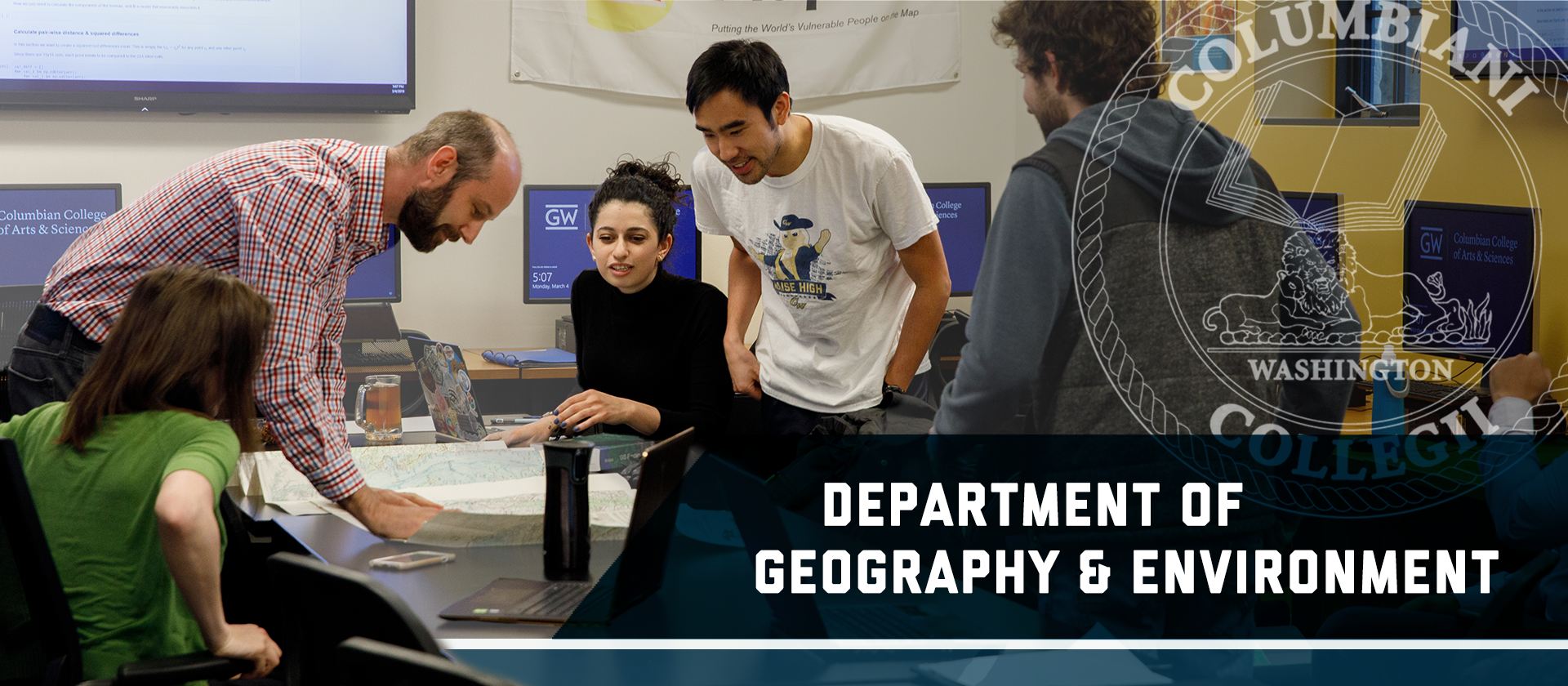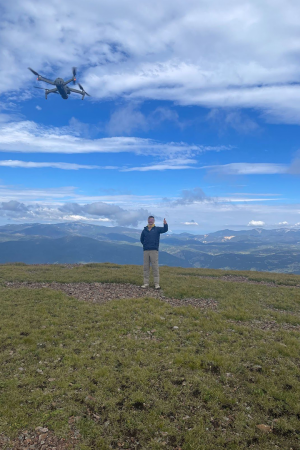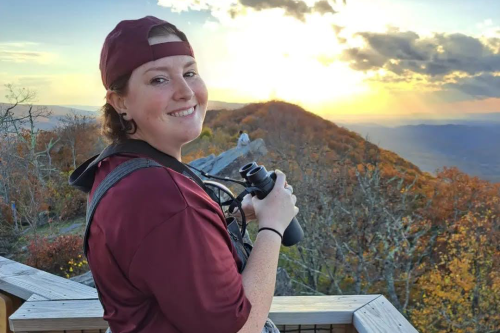2025 Geography & Environment Newsletter

Message from the Chair
Department Spotlights
Faculty Kudos
Alumni Class Notes
Message from the Chair

Greetings to our alumni!
In this newsletter, you’ll read about a few of the exciting things happening in the department.
The Department of Geography and Environment is a community of geographers and environmental scientists engaged in research and teaching that addresses the world’s most critical issues.
Among the highlights from the 2024-25 academic year:
We officially changed our name to the Department of Geography and Environment, to reflect our environmental interests better. We also adopted this tagline for the department:
Find Your Place, Map Your Future
We celebrated our name change with a student-focused departmental celebration during the Alumni and Families Weekend on October 18-20. Our assembled alumni panel included representatives from all employment sectors. Students and alumni participated in a speed-dating-style round robin activity. Over 50 students attended.

To further support student career development, our department hosted our first-ever Career Fair in January, connecting students with top geospatial employers.
We support our departmental community by hosting Speaker Series events—to which alumni are always invited—during the academic year.
Our faculty, staff and students work actively to create and maintain community in our department. Our kitchen is a popular place to meet and go over homework assignments or get a snack and catch up on reading. Our many engagement activities with students include coffee with profs, s’mores, tea times, knitting circles and games nights.

Alumni engagement is important to us! Drop us a line or stop by the department during this year’s Alumni and Families Weekend in October.
Sincerely,
David Rain
Associate Professor of Geography and International Affairs
Department Chair
Department Spotlights

Alumna Emily Zhang Leads School Greening Project
Project Manager and Geography alumna Emily Zhang, BA, ’19, MS ’21, works with Space to Grow, Chicago’s green schoolyards program with the Healthy Schools Campaign. Space to Grow partners with the city’s school district and two water agencies to transform asphalt schoolyards into multifunctional, community-centered spaces that support outdoor learning, connection to nature, play and green stormwater infrastructure. The program has renovated 36 schoolyards, with a primary focus on the city’s historically disinvested communities on the South and West sides. Combined, the schoolyards can hold 7 million gallons of stormwater every time it rains, addressing neighborhood flooding challenges while expanding green space. In an impact report, Space to Grow shared stories and the successes of the program's first 10-years.
“During my time with GW Geography, I was introduced to community-centered planning and design and the critical role that urban environments play in advancing environmental justice and access to nature," Emily said. “These are principles I carry with me in my work with Space to Grow.”

Grad Uses Drone to Research Trail Degradation in New Mexico
For his thesis project, John Lesko, MS ’25, measured and modeled outdoor trail degradation from recreation using high resolution drone imagery. His analysis focused on three trails located on Philmont Scout Ranch, a Scouting America high adventure base in Cimarron, New Mexico. He used a combination of orthomosaic imagery and digital surface models to measure key characteristics of trail degradation such as incision, width, rugosity and grade.
“The project was a blast as it combined my passion for outdoor conservation with my love for GIS/RS tools,” John said. “I had the opportunity to return to New Mexico this summer to collect additional data for change-over-time analysis.”
This project was made possible through the generosity of the alumnus Fritz Hoeschler, BA ’95, whose contribution allowed critical repairs to the department drone to be made.

Welcome New Faculty Member Paige Van de Vuurst McClure
Visiting Assistant Professor Paige Van de Vuurst McClure joins us this fall to teach courses such as Society & Environment and Socio-Ecological Systems. Dr. McClure brings field research skills and a willingness to collaborate across disciplinary boundaries.
Dr. McClure is a disease ecologist and biogeographer from East Tennessee. She recently graduated from the Laboratory of Disease Ecology and Biogeography at Virginia Tech, where she completed a Msc in Wildlife Conservation and a PhD in Translational Biology, Medicine, and Health. Her research focused on the impacts of landscape and climate change on zoonotic diseases, with an emphasis on the transmission of the rabies virus by vampire bats. Prior to graduate school, she graduated from Samford University in Birmingham, Alabama, and served as a Peace Corps Volunteer in Tanzania.
Faculty Kudos
- Dr. Lisa Benton-Short played an important role in the life of the Geography Department for many years, shepherding the department through two physical moves, the COVID-19 pandemic and an Academic Program Review. She rounded out her time at GW with a well-deserved retirement in spring 2025.
- Drs. Elizabeth Chacko and Marie Price held a Migration and Security Workshop focusing on data analysis for asylum seekers in the Rio Grande Valley, as part of their NSF-funded research on the U.S.-Mexico border.
- Dr. Declan Cullen continues to research and write about the gig economy, and he’s a mainstay in the department for teaching and academic advising.
- Dr. Moses Kansanga received tenure and promotion to associate professor in the Elliott School of International Affairs.
- Dr. Aman Luthra’s Pollinator Commons grant was funded by NSF. In addition, Dr. Luthra was funded to continue work on biocultural heritage in Arctic cities.
- Dr. Mike Mann was successful in securing over $1 million in external grants from the U.S. government and companies like Meta and Cesium, to enhance OpenStreetMap (OSM) data, develop geospatial tools for financial and environmental research and improve pedestrian infrastructure accessibility.
- Drs. Nikolay Shiklomanov and Dima Streletskiy and received word that their CALM (Circumpolar Active Layer Monitoring Network) VI grant from the National Science Foundation is funded through 2029 for $1.2 million.
Alumni Class Notes
- Arjun Awasthi, BA ’13, recently completed his PhD in criminology at the University of Southampton on luxury fashion and illegal wildlife and is now working on environmental policy and public engagement projects in the United Kingdom.
- Frederick Hoeschler, BA ’95, moved to Denver, Colorado, and is a United Airlines captain flying the 737.
- Deirdre O’Leary, BA ’91, is a government contractor with Leidos. She lives and works in Northern Virginia.
- Marisha Pena, BA ’07, is working as a roadway design engineer for the Georgia Department of Transportation in Atlanta, Georgia.

